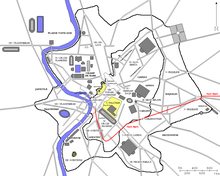Aqua Appia
| Aqua Appia | |
|---|---|
| Construction year | 312 BC Chr. |
| length | 16.5 km |
| Headwaters | Valley of the Aniene east of Rome |
| Height of the source above sea level |
30 m |
| Height in Rome | 20 m |
| Cross section in the lower reaches (W × H in m) |
0.7 x 1.7 |
The Aqua Appia is the oldest aqueduct ( aqueduct ), which in ancient times to supply the city of Rome was built.
history
The Aqua Appia was the first Roman drinking water pipe to be built in 312 BC. Built by the censors Appius Claudius Caecus and Gaius Plautius Venox . Appius Claudius Caecus had the Via Appia built in the same year .
The water pipe had to be repaired several times. This happened under Quintus Marcius Rex between 144 and 140 BC. BC, then under Marcus Vipsanius Agrippa in 33 BC. And under Emperor Augustus between 11 and 4 BC Chr.
Water flow
It was fed by springs that rose between the eighth and ninth milestones of Via Praenestina and were about 1155 m away from it. The source catchment was probably built by Gaius Plautius Venox.
The 16.4 km long canal entered the city at the Porta Maggiore , flowed past the Porta Capena over the Caelius , and ended at the Forum Boarium , near the Porta Trigemina . It transported up to 73,000 cubic meters of water per day to Frontinus . The Aqua Appia was laid underground to protect and secure the water supply to Rome during the Samnite Wars .
The fact that the channel, which runs almost completely underground, only has a height difference of 10 meters between the source and the destination, is for the 4th century BC. Remarkable.
In 2016, a section was exposed in the course of construction work for metro line C near the Colosseum on Rome's Piazza Celimontana. The approximately two meter high water pipe consists of five layers of tuff , on top of which there were two smaller tuff stones in a V shape, which covered the entire route, which was safely plastered inside. The exposed 32 meter long section was located in a ventilation shaft of the metro at a depth of 17.50 meters below street level.
See also
literature
- Samuel Ball Platner , Thomas Ashby : A Topographical Dictionary of Ancient Rome. Oxford University Press, London 1929, p. 21, ( digitized version ).
- Filippo Coarelli : Rome. An archaeological guide. von Zabern, Mainz 2000, ISBN 3-8053-2685-8 , pp. 36-37, 202.
- Lawrence Richardson : A New Topographical Dictionary of Ancient Rome. Johns Hopkins University Press, Baltimore MD et al. 1992, ISBN 0-8018-4300-6 , pp. 15-16 (Aqua Appia).
Web links
- Article Aqua Appia , in Platner / Ashby, A Topographical Dictionary of Ancient Rome (1929)
- Aqua Appia on the website Romanaqueducts (English)
Individual evidence
- ^ Edoardo Sassi: Roman Aqueduct Discovered under Piazza Celimontana . In: Corriere della Sera of April 5, 2017; Joerg Bremer: Aqua Appia against line C . In: Frankfurter Allgemeine Zeitung of April 10, 2017.
